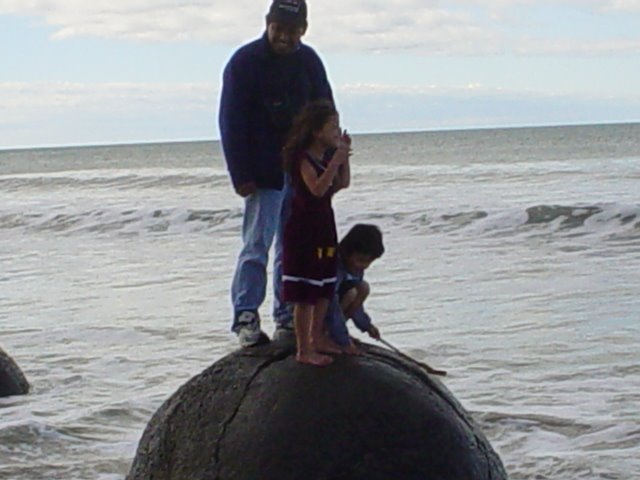RBNZ 'swimming against current' and prescribed the wrong remedy
New Zealand subscribe to the open economy dogma. Its free market, not much control whatsoever. RBNZ can only use interest rate as a tool to influence the firection of the economy.
Problem numero uno: Housing market bubble.
Which result in hot consumer good market because home owner feel rich and buy things. Add to these, the world commodity market is booming, and New Zealand has been getting good returns on its milk products.
So RBNZ has been trying to dampen the economy by increasing interest rate.
By raising interest rate, more money flow into New Zealand. Exchange rate gone up to stratosphere.
Swept on global currents
Sunday Star Times | Sunday, 17 June 2007
Despite his extraordinary intervention, forces driving the kiwi are beyond Bollard's control. Tim Hunter reports.
The dollars keep flowing in - $100 million here, $48m there. Each deal ratchets up demand for New Zealand's currency, demand that pushed the kiwi to a record high of US76c a week ago and triggered unprecedented action by the Reserve Bank on Monday.
The bank's interventionist cattle prod jerked the kiwi back to about US75c, but it's still in the stratosphere compared to its long run average around US60c.
The question is, has the prodding made buyers of kiwi more cautious?
And who are these people anyway?
On the same day bank governor Alan Bollard was selling kiwi dollars by the million, Bloomberg carried a story about Michiko Takeda, a 46-year-old housewife from Sapporo. Last year she deposited 2 million yen (about $20,000) with ANZ in Australia for one year, attracted by interest of 7% compared to the 0.35% she could get with Mitsubishi UFJ Financial Group.
"Even with exchange-rate risks, I'd like to invest more," she told Bloomberg.
There are lots of people like Takeda in Japan, and in other countries where interest rates are low, such as Switzerland. For them the deal is simple - they want to invest in the higher interest rates available in other countries.
New Zealand has the highest interest rate of industrialised countries at 8%, but there are attractions elsewhere - Turkey, for example, can offer deposit rates of more than 18%; Brazil's benchmark rate is 12%, down from 19% 18 months ago.
The risk of investing in currencies is considerable. In the last two years $1 has varied in value between 68 yen and 91 yen -get your timing wrong and any interest rate gains are obliterated by adverse currency movements. Get lucky, though, and gains are multiplied many times.
But Takeda is unusual in opening a deposit account overseas. Most retail investors buy their kiwi investments from domestic institutions - an arrangement that conveniently funds mortgage lending here in New Zealand.
The funding trail is revealed in bland bond issue reports - on May 25, for example, the AAA-rated World Bank raised $633m with an issue of uridashi bonds, marketed to Japanese institutions and the public by Daiwa Securities. The bonds were paying 6.76% on face value.
These issues - by institutions like German state-owned KfW, Swedish Export Credit Corp, Toyota Motor Credit Corp - happen several times a month. Since January they have raised $4.313 billion, according to figures from the Reserve Bank.
The same thing goes on in Europe, where instutions like Rabobank and Inter American Development Bank raise NZ dollars by issuing eurokiwi bonds - $5.015b worth since January.
How much of this activity contributes to buying pressure on the kiwi is hard to calculate because some of it will be rolled over from previous issues, but cumulatively there has been huge growth in the trade.
Netting out issues and redemptions, the amount outstanding on uridashis has risen from zero in January 2003 to $21.87b two weeks ago.
Eurokiwi issuance is bigger still. Over the same period eurokiwi debt outstanding has risen from $12.07b to $34.2b.
That's a total of $56b. To put that figure into perspective, total NZ dollar funding in New Zealand banks is $200.9b.
Unfortunately the precise destination of the $56b is unknown, but the bulk of it appears to be funding bank loans in New Zealand through swap deals arranged overseas.
These deals work because overseas investors want to tap into high kiwi interest rates, but prefer to do it through familiar AAA-rated institutions rather than unknown NZ banks. So the World Bank can raise NZ dollars from European and Japanese investors at a fixed rate -with uridashis and eurokiwis - much more cheaply than ANZ, say.
But the World Bank doesn't want kiwi, it wants greenbacks or euros.
ANZ, meanwhile, can borrow euros at a variable rate, so it swaps the euro funds and variable interest rate for the World Bank's fixed rate kiwi at a "swap" rate that allows both to gain advantage from the deal.
These swaps have been hugely beneficial to New Zealand borrowers, much to Bollard's frustration. At times, notably in mid-2005 and the first half of 2006, swap rates have been below the official cash rate, so NZ banks able to access this market could offer highly competitive fixed rate deals.
The effect on house prices is another story, but what of the effect on the dollar?
Some commentators have focused on the unwinding of uridashi and eurokiwi bonds as likely to trigger a dollar drop. In October, for example, $1.6b of eurokiwi and $2.2b of uridashi are due for repayment.
The redemptions may have an effect, but they haven't in the past. As long as overseas investors continue to want to hold kiwi they will simply roll over the money into another kiwi bond.
Economist Anthony bYETT of FX Matters picks investor psychology as the deciding factor. A change in sentiment, some negative press coverage, and enthusiasm for uridashis and eurokiwis could evaporate.
"There's a fairly naive investor on the end of all this," he said. "They're offered a handsome return compared to the local post office, but I don't think they really understand the currency risk."
Byett sees a potential turnaround towards the end of this year, particularly if Japan's central bank raises interest rates.
If that happens, the effect on the kiwi will be amplified by hedge funds, whose currency deals are much larger than those in the swaps trade. Rumour has it that over the two weeks before Bollard's intervention, hedge funds bought between $5b and $10b.
This is the infamous "carry trade", where big funds borrow at low rates to invest in high interest rate currencies. These funds differ from the swap trade investors in that they invest for the short term, perhaps only a few weeks.
If retail investors like Takeda don't care about currency risk, the hedge funds certainly do, and on that score the Reserve Bank's currency intervention made global markets sit up and concentrate.
Byett described the bank's approach as "guerilla action", taking an opportunistic position in the market rather than drawing up battle lines.
"If you see the dollar spike up a cent or two it's a good time to sell," he said. "But if you get a data event next week that pushes up the likelihood of a rate rise, the dollar will be back up to 76c.
"Will the bank intervene again? I'm not so sure."







No comments:
Post a Comment